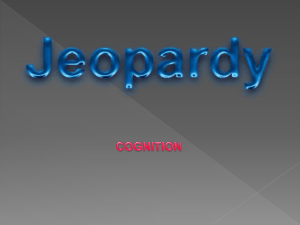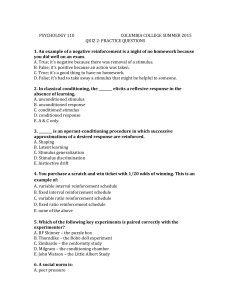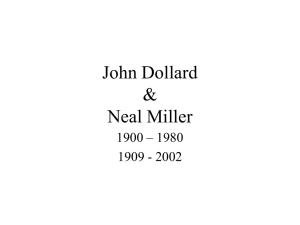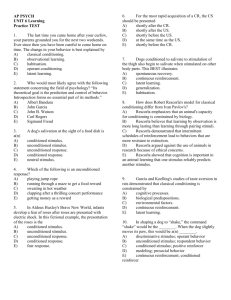Psychology 155 – Intro to Personality Study Guide for Test 2 I have
advertisement
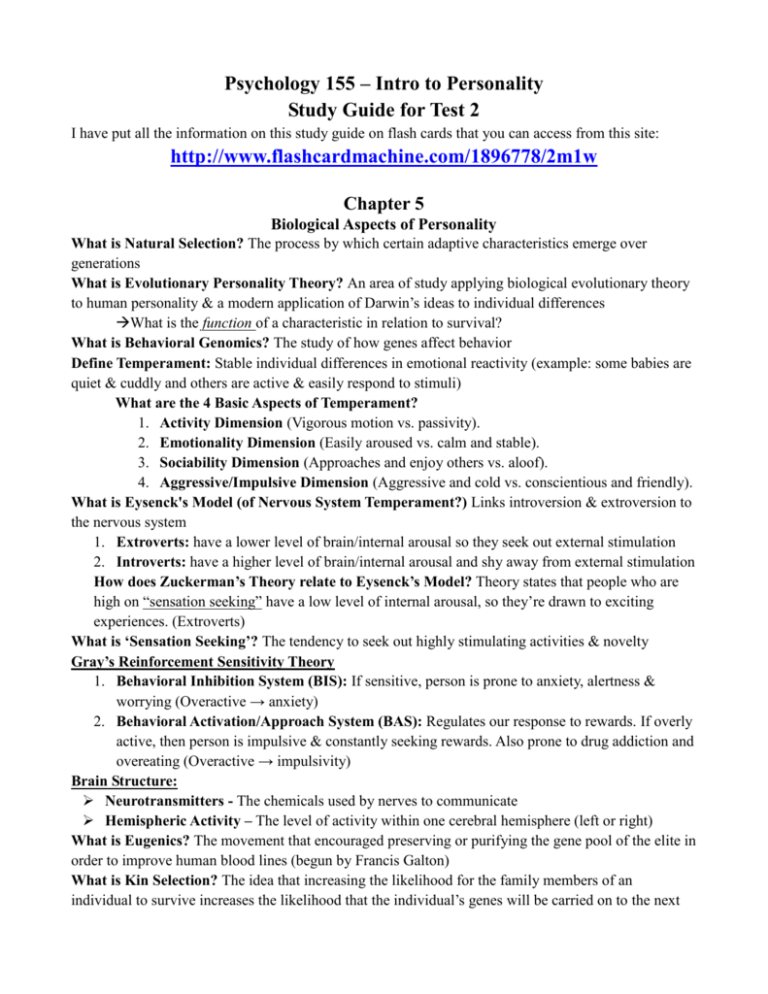
Psychology 155 – Intro to Personality Study Guide for Test 2 I have put all the information on this study guide on flash cards that you can access from this site: http://www.flashcardmachine.com/1896778/2m1w Chapter 5 Biological Aspects of Personality What is Natural Selection? The process by which certain adaptive characteristics emerge over generations What is Evolutionary Personality Theory? An area of study applying biological evolutionary theory to human personality & a modern application of Darwin’s ideas to individual differences What is the function of a characteristic in relation to survival? What is Behavioral Genomics? The study of how genes affect behavior Define Temperament: Stable individual differences in emotional reactivity (example: some babies are quiet & cuddly and others are active & easily respond to stimuli) What are the 4 Basic Aspects of Temperament? 1. Activity Dimension (Vigorous motion vs. passivity). 2. Emotionality Dimension (Easily aroused vs. calm and stable). 3. Sociability Dimension (Approaches and enjoy others vs. aloof). 4. Aggressive/Impulsive Dimension (Aggressive and cold vs. conscientious and friendly). What is Eysenck's Model (of Nervous System Temperament?) Links introversion & extroversion to the nervous system 1. Extroverts: have a lower level of brain/internal arousal so they seek out external stimulation 2. Introverts: have a higher level of brain/internal arousal and shy away from external stimulation How does Zuckerman’s Theory relate to Eysenck’s Model? Theory states that people who are high on “sensation seeking” have a low level of internal arousal, so they’re drawn to exciting experiences. (Extroverts) What is ‘Sensation Seeking’? The tendency to seek out highly stimulating activities & novelty Gray’s Reinforcement Sensitivity Theory 1. Behavioral Inhibition System (BIS): If sensitive, person is prone to anxiety, alertness & worrying (Overactive → anxiety) 2. Behavioral Activation/Approach System (BAS): Regulates our response to rewards. If overly active, then person is impulsive & constantly seeking rewards. Also prone to drug addiction and overeating (Overactive → impulsivity) Brain Structure: Neurotransmitters - The chemicals used by nerves to communicate Hemispheric Activity – The level of activity within one cerebral hemisphere (left or right) What is Eugenics? The movement that encouraged preserving or purifying the gene pool of the elite in order to improve human blood lines (begun by Francis Galton) What is Kin Selection? The idea that increasing the likelihood for the family members of an individual to survive increases the likelihood that the individual’s genes will be carried on to the next generation even if the individual did not reproduce him- or herself. What is Nonshared Environmental Variance? How children raised in the same home experience features of that environment differently Genetics Effect on Personality: Schizophrenia: A condition whose symptoms include distorted reality, odd emotional reactions & sometimes paranoia and/or delusions Bipolar Disorder/Manic-Depression: Disorder which an individual swings regularly between bouts of wildly enthusiastic energy and bouts of hopeless depression Angelman Syndrome: Causes children to be especially attractive and friendly but also suffer mental retardation, sleep very little and walk with a jerky movement. Caused by a defect on a chromosome Williams Syndrome: Having an excessively social personality, as well as limited spatial skills and intellectual ability Effects of Biology What are some environmental toxins/poisons and their effects on personality? People may start acting strangely & changes in personality occur Mercury Poisons a child’s developing nervous system, impairing cognitive function and Lead producing deviant/anti-social behavior Sometimes become compulsive fighters & later develop Parkinson’s disease Manganese What are some Physical Illnesses and their effects on personality? An ailment of the brain’s cerebral cortex. Starts with quirks in behavior and some Alzheimer’s memory loss and ends in a total loss of original personality Hemorrhage that damages a part of the brain & can cause a kind person to become Strokes aggressive and uncooperative & vice versa. Inner ear disorder that produces dizziness, nausea & auditory disturbances (Van Ménière’s Gogh may have suffered from this disease) What is Biological Determinism? The belief that an individual’s personality is completely determined by biological (and especially by genetic) factors What is Psychopharmacology? The study of the role of drugs and other toxic substances in causing and treating psychiatric disturbance Prescribed drugs have short and long term effects on personality Illegal drugs also effect personality (cocaine produces symptoms of paranoia) What is Tropism? The tendency to seek out specific types of environments. Some individuals grow towards more fulfilling and health-promoting spaces while others remain subject to darker, healththreatening environments Looks & Personality What is Somatypology: Theory relating body type to personality characteristics (W.H. Sheldon) What are Sheldon’s 3 Body Types? 1. Mesomorph – Large-boned, muscular, athletic type 2. Ectomorph – Slender, bookworm type 3. Endomorph – Roly-poly, supposedly good natured type What is Survival of the Fittest? The concept that species evolve because those individuals who cannot compete well in the environments in which they live tend to be less successful in growing up and producing offspring What is Social Darwinism? The idea that societies and cultures naturally compete for survival of the fittest What is Sociobiology? The scientific study of the influence of evolutionary biology on an organism’s responses regarding social matters What is Biological determinism? The belief that an individual's personality is completely determined by biological factors (and especially by genetic factors) Chapter 6 Behaviorist & Learning Aspects of Personality What is Classical Conditioning? Give an example. After a repeated pairing of an unconditioned stimulus that elicits an unconditioned response and a neutral stimulus, the previously neutral stimulus can come to elicit the same response as the unconditioned stimulus. (e.g. Pavlov’s Dog) Can be used to explain emotional aspects of personality Neurotic behavior Phobias Superstitious behavior What is Partial Reinforcement? A reward that occurs after some, but not all, occurrences of a behavior (**way to remember: PARTIAL reinforcement- PART of the time) What is Generalization? The tendency for similar stimuli to evoke the same response What is Discrimination? The concept that a conditioned response will not occur for all possible stimuli, indicating that an animal can learn to tell the difference between stimuli What is Extinction? When the pairing of the conditioned and unconditioned stimulus stops What is the difference between a conditioned response and an unconditioned response? Conditioned means a ‘learned’ response and Unconditioned means the natural or ‘un-learned’ response What is the difference between a conditioned stimulus and an unconditioned stimulus? The conditioned stimulus is a previously neutral stimulus that, after becoming associated with the unconditioned stimulus, eventually comes to trigger a conditioned response. The unconditioned stimulus is one that unconditionally, naturally, and automatically triggers a response. What is a Neutral Stimulus? A stimulus that initially or normally does not elicit an overt behavioral response (apart from focusing attention) THE NATURAL CAUSE & EFFECT (PHASE 1/BEFORE) FOOD Unconditioned STIMULUS SALIVATION Unconditioned RESPONSE INTRODUCING THE CONDITIONED STIMULUS (PHASE 2) BELL RINGS Neutral STIMULUS FOOD Unconditioned STIMULUS SALIVATION Unconditioned RESPONSE THE CONDITIONED CAUSE & EFFECT (PHASE 3/AFTER) BELL RINGS Conditioned STIMULUS SALIVATION Conditioned RESPONSE What is Behaviorism? The study of observable behavior (WATSON) What is Systematic Desensitization? Gradually extinguishing a phobia by causing the feared stimulus to become dissociated from the fear response What is Radical Determinism? The belief that all human behavior is caused and that humans have no free will What is Operant Conditioning? The changing of a behavior by manipulating its consequences What is Reinforcement? An event that strengthens a behavior & increases the likelihood of repeating the behavior in the future (SKINNER) REINFORCEMENT = If the preceding response INCREASES after the consequence occurs PUNISHMENT = If the preceding response DECREASES after the consequence occurs Reinforcement or punishment can occur through adding OR removing a stimulus What happens AFTER the response occurs? Stimulus is Added Stimulus is Removed Response Increases What Positive Negative happens to Reinforcement Reinforcement the response? Response Decreases Positive Punishment Negative Punishment What is Thorndike’s Law of Effect? Concept that the consequence of a behavior will either strengthen or weaken behavior, i.e. when a response follows a stimulus and results in satisfaction, this strengthens the connection between stimulus and response; however, if the response results in discomfort or pain, the connection is weakened SATISFACTION CONNECTION STRENGTHENED STIMULUS DISCOMFORT/PAIN CONNECTION WEAKENED What is Shaping? The process in which undifferentiated operant behaviors are gradually changed or shaped into a desired behavior pattern by the reinforcement of successive approximations, so that the behavior more and more resembles the target behavior What is Negative Reinforcement? An aversive event that ends if a behavior is performed, making it more likely for that behavior to be performed in the future What are Habits? Associations between a stimulus and a response (HULL) What are Primary Drives? A fundamental innate motivator of behavior, specifically hunger, thirst, sex or pain What is Social Learning Theory? A theory that proposes that habits are built up in terms of a hierarchy of secondary drives What are Secondary Drives? Drives that are learned by association with the satisfaction of primary drives What is Habit Hierarchy? A learned hierarchy of likelihoods that a person will produce particular responses in particular situations Drive Conflicts: Approach-Avoidance Conflict: Conflict between primary and secondary drives that occurs when a punishment results in the conditioning of a fear response to a drive. Approach-Approach Conflict: Conflict in which a person is drawn to two equally attractive choices. Avoidance-Avoidance Conflict: Conflict in which a person is faced with two equally undesirable choices. Frustration-Aggression Hypothesis: Aggression is the result of blocking, or frustrating, a person's efforts to attain a goal. What is the Act-Frequency Approach? Assessing personality by examining the frequency with which a person performs certain observable actions Chapter 7 Cognitive and Social-Cognitive Aspects of Personality What is Gestalt Psychology? An approach to psychology that emphasizes the integrative and active nature of perception and thought suggesting that the whole may be greater than the sum of its parts What is Lewin’s Field Theory? Behavior is determined by complex interactions among a person’s internal psychological structure, the forces of the external environment, and the structural relationships between the person and the environment What is Life Space? All the internal and external forces that act on an individual What is Contemporaneous Causation? Behavior is caused at the moment of its occurrence by all the influences that are present in the individual at that moment What is Cognitive Style? An individual’s distinctive, enduring way of dealing with everyday tasks of perception and problem solving What is Field Dependence? A cognitive style variable that is the extent to which an individual’s problem solving is influenced by salient but irrelevant aspects of the context in which the problem occurs Relies on perception- a cognitive process- as the basis for the explanation More females tend to be Field Dependent What is Field Independence? A cognitive style variable that is the extent to which an individual’s problem solving is NOT influenced by salient but irrelevant aspects of the context in which the problem occurs Field Independent children’s Play Preference: favor solitary play Field Independent people’s Socialization Patterns: emphasize autonomy over conformity Field Independent people’s Career Choice: prefer technological occupations What is Cognitive Complexity? The extent to which a person comprehends, utilizes, and is comfortable with a greater number of distinctions or separate elements into which an entity or event is analyzed, and the extent to which the person can integrate those elements by drawing connections or relationships among them What is Learning Style? The characteristic way in which an individual approached a task or skill to be learned What are Schemas? A cognitive structure that organizes knowledge and expectations about one’s environment- determines how we think and act What are Scripts? A schema that guides behavior in social situations (e.g. eating at a restaurant) What are Stereotypes? A schema or belief about the personality traits that tend to be characteristic of members of some group What is Categorization? The perceptual process by which highly complex ensembles of information are filtered into a small number of identifiable and familiar objects and entities Positive effects of categorization: Quickly understand complex information Make likely inferences about new things Negative effects of categorization: Stereotypes Overlook individuating characteristics What is Control of Attention? Noticing salient environmental features and combine these with our current goals to decide where to direct our attention What is Situated Social Cognition? Social cognitive processes with changes in the situation What is Rejection Sensitivity? A personality variable capturing the extent to which an individual is overly sensitive to cues that he or she is being rejected by another What is Personal Construct Theory? Emphasizes the idea that people actively endeavor to construe or understand the world and construct their own theories about human behavior (KELLY) What is the Role Construct Repertory Test? An assessment designed by George Kelly to evoke a person’s own personal construct system by making comparisons among triads of important people in the life of the person being assessed What is Social Intelligence? The idea that individuals differ in their level of mastery of the particular cluster of knowledge and skills that are relevant to interpersonal situations What is Emotional Intelligence? The set of emotional abilities specific to dealing with other people What is Emotional Knowledge? The ability to recognize and interpret emotions in the self and others What are Multiple Intelligences? Theory that claims that all human beings have at least seven different ways of knowing about the world and that people differ from one another in the relative strengths of each of these seven ways: 1. Language, 2. Logical-Mathematical Analysis 3. Spatial Representation 4. Musical Thinking 5. Bodily-Kinesthetic Intelligence 6. Understanding the Self 7. Understanding Others What is Explanatory Style? A set of cognitive personality variables that captures a person’s habitual means of interpreting events in his/her life Optimism & Pessimism – Optimistic style is generally associated with positive aspects & better outcomes of a situation. Pessimism is associated with negative aspects & worse outcomes of a situation. What is Defensive Pessimism? The approach of anticipating a poorer outcome, thus reducing anxiety and actually improving performance in a risky situation What is Learned Helplessness? Repeated exposure to unavoidable punishments leads an organism to accept later punishment even when it is avoidable, e.g. dogs getting shocked no matter which room they were in (SELIGMAN) What is Learned Optimism? An optimistic style that people can be trained to achieve What is Cognitive Intervention? Teaching people to change their thought process JULIAN ROTTER’S LOCUS OF CONTROL APPROACH: What is Outcome Expectancy? The extent to which an individual expects his or her performance to have a positive result What is Reinforcement Value? The extent to which an individual values the expected reinforcement of an action ACCORDING TO ROTTER… Our final choice of behavior depends on both the outcome expectancy & the reinforcement value What is Behavior Potential? The likelihood that a particular behavior will occur in a specific situation What is Specific Expectancy? The expectancy that a reward will follow a behavior in a particular situation What is Generalized Expectancy? The expectancy that is related to a group of situations What did Rotter think of the Role of Reinforcements? The greater the subjective value of the reinforcement, the more likely a person is to perform a behavior associated with that valued reinforcement What is a Secondary Reinforcement? A conditioned reinforcement- a previously neutral stimulus that becomes a reinforcer following its pairing with a primary reinforcer. What is the Locus of Control? The variable that measures the extent to which an individual habitually attributes outcomes to factors internal to the self, versus external to the self What is the Internal Locus of Control? The generalized expectancy that an individual’s own actions lead to desired outcomes What is the External Locus of Control? The belief that things outside of the individual determine whether desired outcomes occur What are Rotter’s 6 Psychological Needs? 1. Recognition-status 2. Dominance 3. Independence 4. Protection-dependency 5. Love & Affection 6. Physical Comfort ALBERT BANDURA’S SOCIAL COGNITIVE LEARNING THEORY: What is the Self-System? The set of cognitive processes by which a person perceives, evaluates, and regulates his/her own behavior so that it is appropriate to the environment and effective in achieving goals What is Observational or Vicarious Learning? Learning by an individual that occurs by watching others perform the behavior, with the individual neither performing the behavior nor being directly rewarded or punished for the behavior (AKA Modeling) What are some processes underlying Observational Learning? Attention Retention Motor Reproduction Motivation What is Self-Regulation? Monitoring one’s own behavior as a result of one’s internal processes of goals, planning and self-reinforcement What is Self-Efficacy? An expectancy or belief about how competently one will be able to enact a behavior in a particular situation Based on: past successes/failures at similar tasks Vicarious experiences (seeing others) Verbal Persuasion (by others) Specific to the situation/behavior (unlike self-esteem, which is global) What is the Turing Test? A standard test by which to judge whether a computer can adequately simulate a human; in this test, first proposed by Alan Turing, a human judge interacts with two hidden others and tries to decide which is the human and which is the computer

